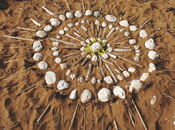 Children, teens, and even adults can enjoy the benefits of making art outdoors with natural materials.
Children, teens, and even adults can enjoy the benefits of making art outdoors with natural materials.
As summer shimmers on the horizon, there is no doubt about it: outdoors is the place to be. Despite the challenges of the current moment, local and global, we can find well-being and feel connected[1] in nature.
Many of us are intuitively drawn to nature in times of stress, uncertainty, or grief. It may come as no surprise, then, that our "nature instinct" is supported by science: being outside can help our children and ourselves feel calmer, healthier, and kinder[2]. Interacting with nature can boost children and youth's mental health, reduce stress, and improve ADHD symptoms[3]. Some experts have even declared time in nature an essential part of a "balanced diet" of childhood experiences due to it's positive effects on children's development and well-being.
While feeling in awe of nature is good for us[4], being creative in nature is another pathway to well-being. Making art can decrease anxiety[5], increase pro-social behaviour[6], and even reduce the levels of cortisol[7] (a powerful stress hormone) in our bodies.
Read on to learn 10 ways to spark creativity and calm through nature art.
 1. Create a whimsical earthscape.
1. Create a whimsical earthscape.
Use a garden rake or rope to make a larger-than-life design [8]on the beach at low tide. Target audience: secondary students in grades 8-12.
2. Get crafty with insect art.
Be sure to photograph your image (from above works best) before returning materials to the compost bin. Target audience: intermediate students in grades 4-7.
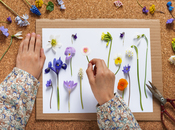 3. Let nature shine with a flower suncatcher.
3. Let nature shine with a flower suncatcher.
Flowers, petals, herbs, pine needles, leaves, feathers, and other nature objects that can be laid flat work well for this activity. Target audience: primary students in grades K-3.
4. Make a mandala with natural materials.
Invite students to walk mindfully around the mandalas upon completion for an added boost of calm. Target audience: all ages.
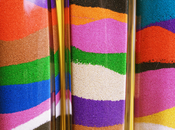 5. Bring the beach home with sand art bottles.
5. Bring the beach home with sand art bottles.
Use recycled glass bottles or jars if possible. If sand in your area is too dark to dye, make beach combing jars [9]instead. Target audience: young students in pre-K to grade 3.
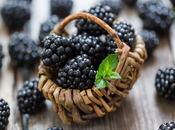 6. Celebrate British Columbia's Indigenous heritage by weaving a wild blackberry basket.
6. Celebrate British Columbia's Indigenous heritage by weaving a wild blackberry basket.
Ensure to wear gloves, use native species, and clean the vines well to avoid getting pricked by pesky thorns! Use your basket to collect ripe blackberries or other safe-to-eat foraged foods or traditional plants. Watch master basket maker Brenda Crabtree craft a traditional cedar basket here. Target audience: secondary students in grades 8-12.
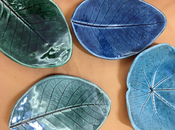
7. Craft a leaf clay dish to preserve nature's beauty year-round.
Paint the whole dish one colour or decorate it with an intricate design - it's up to you! Target audience: intermediate students in grades 4-7.
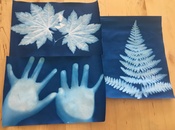 8. Let sunshine make its mark with cyanotope sunprints.
8. Let sunshine make its mark with cyanotope sunprints.
Be sure to work quickly once the paper is exposed to light - it may help to lay out your design beforehand to get it just right. Target audience: all ages.
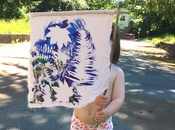 9. Paint an eco-friendly garden flag.[10]
9. Paint an eco-friendly garden flag.[10]
Repurpose used household fabrics into works of garden art! Cotton, canvas, or other natural fibres work best. Target audience: young students in pre-K to grade 3.
 10. Have a whale of a time making rock and sand sea creatures.
10. Have a whale of a time making rock and sand sea creatures.
Younger children can activate their imagination by creating a mythical creature such as a mermaid or sea-monster. Target audience: all ages.
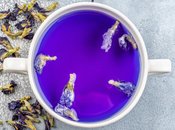 Bonus: Use local plants and flowers to make unique watercolour paints for your nature art projects and beyond!
Bonus: Use local plants and flowers to make unique watercolour paints for your nature art projects and beyond!
In a 2014 systematic review of the literature on children's engagement with nature, Gill found that time spent in nature during childhood is associated with feelings of being connected with the natural world and a stronger sense of place as an adult.
A 2018 systematic review conducted by Canadian researchers found significant evidence that interacting with nature can improve overall mental health, decrease stress, and improve ADHD/ADD symptoms in children and youth aged 0 - 18 years. They also found some evidence that it can boost resillience, combat depression, and enhance health-related quality of life in this population.
UK-based childhood researcher Tim Gill found strong evidence to support these findings in his 2014 systematic review of the literature.
See "Fall In Love With Nature," a Heart-Mind Online resource describing the plentiful benefits of time spent outdoors, and how to reap them.
In a 2018 study, a team of researchers from the University of California, Berkeley found that the awe people feel during extraordinary or daily nature experiences is linked to enhanced well-being and life satisfaction, as well as reductions in stress-related symptoms.
In a 2016 study with young and middle-aged adults at a Canadian university, researchers found that cortisol levels significantly decreased following just 45 minutes of art making with markers, clay, collage or mixed materials.
A 2014 study conducted with 57 undergraduate students at an American university found that art making (eg. painting or coloring pre-designed mandalas, free-form painting, collage making, still life drawing, modeling with clay) significantly decreased both state and trait anxiety compared to controls.These findings suggest that a brief period of art making can significantly reduce a person's state of anxiety.
A 2019 mixed-methods study exploring the effects of art-therapy in a UK primary school found that art-therapy had a significant positive effect on children’s overall stress, conduct, hyperactivity, and pro-social behaviour as reported by their teachers.
For more information, see "The Benefits of Children's Engagement with Nature: A Systematic Literature Review" (2014).
This activity was suggested by Vancouver-based early childhood educator Golda Lewin.
- Cut scrap fabric or an old t-shirt, sheet, or pillow case to size
- Lay leaves, flowers, ferns, branches, and other natural materials on top of your fabric
- Use a sponge or paintbrush to stamp fabric paint overtop of the natural materials (you may need to hold them in place), being sure to cover all the edges to get clear borders
- Let dry in a sunny place
- Attach to a stick or branch using thread, tape, or glue to display in your garden
- Draw your design out before hand (fractals work particularly well) or let inspiration flow from your surroundings.
- Work independently or make it a team-building exercise.
- Be mindful of the rising tide, and take a picture if you can before the sea claims your art!
Beach combing jars: layer found objects of different sizes and textures (such as pebbles, beach glass, shells, etc) in a clean glass container.

